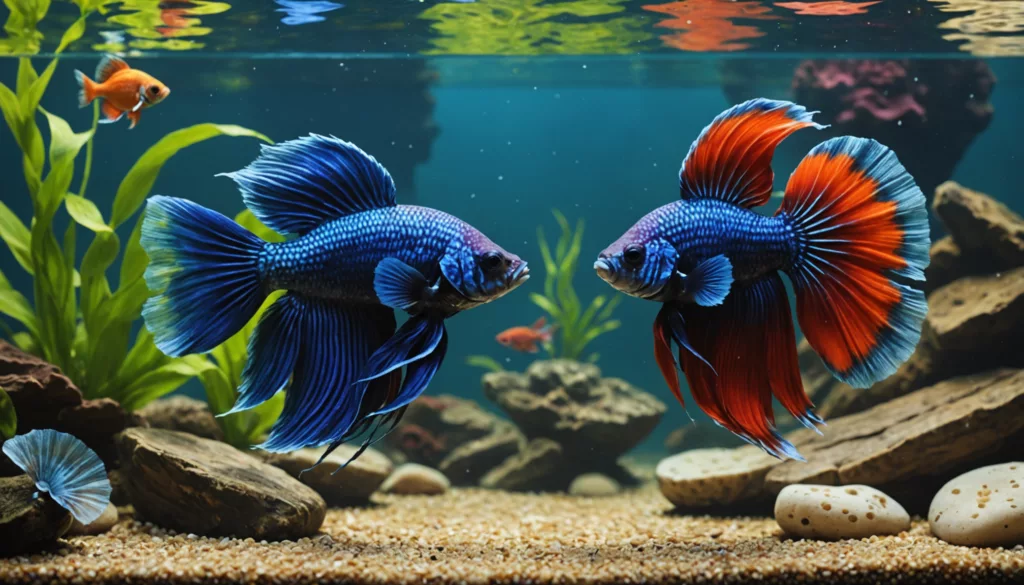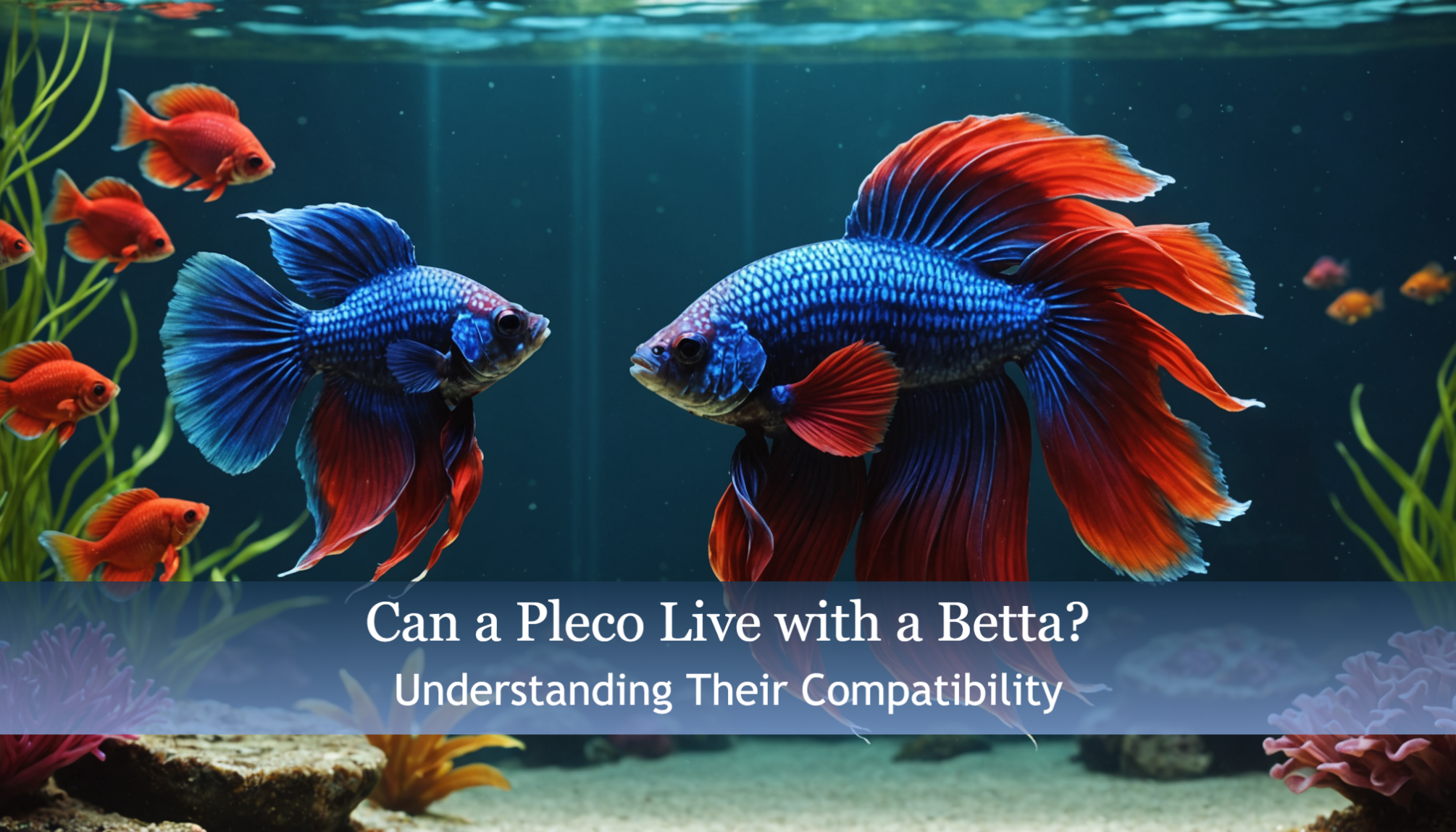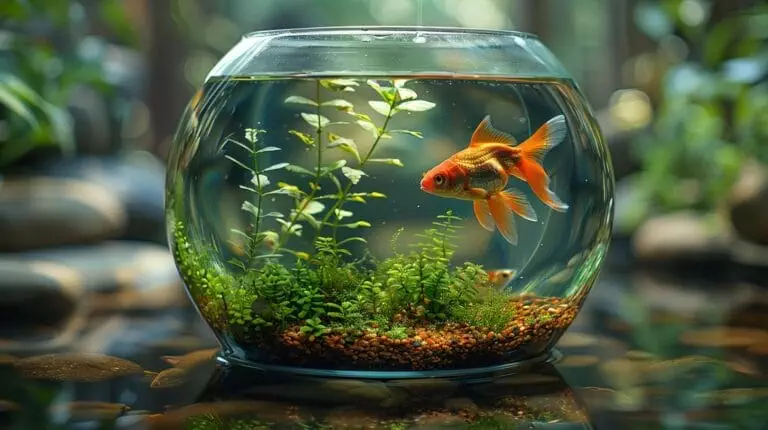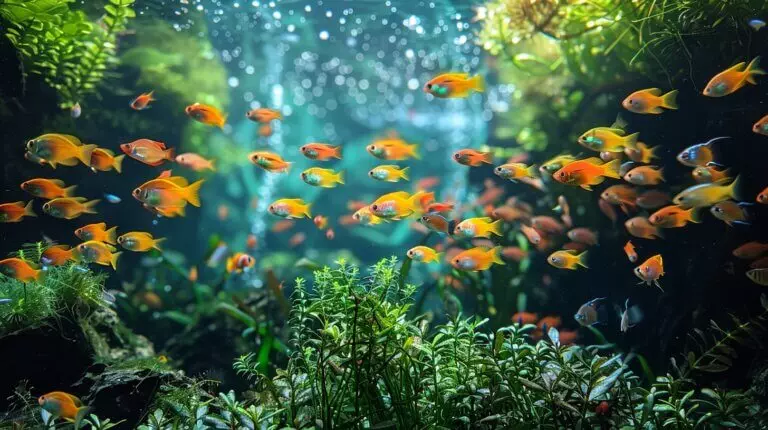Imagine peering into an aquarium filled with vibrant colors, where a graceful Betta fish swims next to a gentle Plecostomus. But wait—can a pleco live with a betta? Understanding their compatibility is essential for any young aquarium enthusiast! This topic matters because choosing the right tank mates can prevent stress and ensure a peaceful environment for your fish. If you don’t take the time to learn about their needs, you might end up with a startled betta or an unhappy pleco.
In this guide, we’ll dive into the fascinating world of Betta and Pleco interactions. We’ll explore their unique characteristics, key factors that affect their relationship, and tips for creating a harmonious aquarium. Plus, you’ll discover how to spot signs of stress in your fish. Ready to unlock the secrets of a perfect community tank? Let’s jump in!
Can a Pleco Live With a Betta? Understanding Compatibility

Overview of Betta Fish and Plecostomus Characteristics
Betta fish, or Siamese fighting fish, originate from Southeast Asia. They are famous for their bright colors and flowing fins. Male bettas can be territorial and may act aggressively towards other male fish. This aggression sometimes results in fin-nipping, where one fish bites another’s fins. To prevent fights, it is important to choose tankmates carefully [1].
Plecostomus, commonly known as plecos, are peaceful bottom dwellers. They help keep aquariums clean by eating algae from surfaces. Plecos can grow large, reaching up to 20 inches (50 cm) in the wild, but they are usually sold much smaller in pet stores. Their algae-eating habits make them a favorite among aquarium enthusiasts [2].
Factors Affecting Betta and Pleco Compatibility
Several factors determine if a pleco can live successfully with a betta fish:
- Size of the Pleco: Smaller species, like the bristlenose pleco, are often recommended because they pose less of a threat to bettas. Larger plecos may intimidate bettas or compete for space [2].
- Tank Size: A suitable aquarium size is crucial. A larger tank allows both fish to have their own space. A 20-gallon long aquarium or larger is ideal for keeping bettas and plecos together [3].
- Hiding Spots: The tank environment significantly affects fish behavior. Providing ample hiding spots, such as caves and dense plants, can help reduce stress and lessen territorial disputes.
Interspecies Behavior: Plecos and Bettas
When bettas and plecos share a tank, their behavior greatly impacts their interactions. Generally, bettas do not target plecos aggressively, especially when they are well-fed and have enough space. Feedback from aquarium communities shows that many experienced aquarists report successful cohabitation [3].
It is important to recognize that not all bettas behave the same. Some may show more aggression towards larger or brightly colored tankmates. Thus, it is essential to monitor fish behavior closely to ensure a peaceful aquarium environment.
References
- Siamese Fighting Fish – Wikipedia
- Hypostomus Plecostomus – Wikipedia
- Community Discussions on Fish Compatibility (Facebook Aquarist Groups)
Choosing the Right Tank Mate for Your Betta

Choosing the right tank mate for a betta fish is important for creating a peaceful aquarium. Bettas, especially males, can be aggressive and territorial. Therefore, selecting compatible species is crucial for a happy tank environment.
Compatibility of Plecostomus in Your Community Tank
Plecostomus, particularly the smaller Bristlenose pleco, often make good tank mates for bettas. These fish are generally peaceful and spend most of their time at the bottom of the tank. This behavior means they are less likely to invade the betta’s territory. However, larger plecos may not be suitable because their size can stress the betta, potentially leading to aggressive behaviors.
To ensure successful cohabitation, the size of the aquarium is critical. A minimum tank size of 20 gallons is recommended for a betta and pleco duo. This size provides enough space for both species to establish their territories. Additionally, a well-decorated tank with plenty of hiding spots made from plants, rocks, and caves can help reduce stress for both fish.
Other Suitable Tank Mates for Betta Fish
In addition to plecostomus, several other fish can live peacefully with bettas. The best companions include:
- Corydoras: These bottom-dwellers are peaceful and thrive in groups.
- Neon Tetras: Small and colorful, they swim in the middle of the tank.
- Harlequin Rasboras: Another peaceful species, they are active and a lovely addition.
It is essential to avoid fin-nipping species or aggressive fish that could provoke the betta. Fish like guppies and some types of barbs can cause trouble.
Signs of Stress in Betta and Pleco Interactions
Monitoring interactions between a betta and a pleco is essential for their well-being. Betta fish may show stress through several behaviors:
- Hiding: Frequent hiding may indicate the betta feels threatened.
- Color Fading: A stressed betta may lose its vibrant colors.
- Aggressive Pursuit: If the betta chases the pleco, it could signal territorial behavior.
Conversely, plecos may show signs of stress through:
- Hiding: Unusual hiding behavior may mean the pleco feels unsafe.
- Changes in Feeding Patterns: If a pleco is not eating well, it may be stressed.
Regular observation of tank dynamics is necessary to ensure the health of both species.
References
- Wikipedia – Siamese fighting fish
- Wikipedia – Hypostomus plecostomus
- Facebook group discussions on aquariums
Creating a Harmonious Aquarium Environment

Creating a peaceful aquarium environment is essential for keeping both bettas and plecos healthy. This section covers the ideal tank conditions, layout, and water quality required for these two species to thrive together.
Ideal Tank Conditions for Bettas and Plecos
To ensure successful coexistence of bettas and plecos, it’s crucial to provide the right tank conditions. Consider these key factors:
- Temperature: Both species prefer warmer water. The ideal range is 76°F to 82°F (24°C to 28°C). Keeping this range stable supports their metabolic processes.
- pH Level: A neutral pH level between 6.5 and 7.5 is best for both species. This level mimics their natural habitat and reduces stress, allowing them to thrive.
- Tank Size: For a peaceful environment, aim for a minimum tank size of 20 gallons. This size provides ample space for swimming and allows both species to establish their territories without conflict.
Establishing these conditions is crucial for maintaining a harmonious environment where both bettas and plecos can coexist peacefully.
Tank Layout and Hiding Spots for Peaceful Co-habitation
The tank layout significantly impacts the comfort and safety of bettas and plecos. Here are tips for creating a suitable layout:
- Hiding Spots: Include plants, rocks, and caves in the tank. These hiding spots offer both fish places to retreat, reducing stress and territorial disputes. Bettas enjoy exploring, while plecos prefer cover.
- Open Swimming Space: Ensure enough open space for swimming. Bettas are active swimmers, and a clear area allows them to display their natural behaviors.
- Aquatic Plants: Use dense plants to create natural barriers. This arrangement helps break lines of sight and reduces aggression. Live or silk plants can be effective in providing cover.
By carefully designing the tank layout, it becomes easier for bettas and plecos to coexist peacefully, as hiding spots and open spaces help manage their interactions.
Maintaining Water Quality in a Mixed Species Tank
Good water quality is vital for the health of all aquarium inhabitants. Proper maintenance helps prevent stress and illness. Follow these key steps to keep water quality high:
- Regular Monitoring: Check water parameters, including temperature, pH, and ammonia levels. Using a quality test kit ensures conditions remain stable.
- Filtration System: Invest in a reliable filtration system to remove waste and maintain clear water. A filter designed for a 125-gallon aquarium can effectively handle the load, even in smaller setups.
- Water Changes: Perform regular water changes every 2-4 weeks to eliminate toxins and replenish essential minerals. Changing 20-30% of the water keeps the environment fresh and clean.
- Avoid Overfeeding: Overfeeding leads to waste accumulation, which deteriorates water quality. Feed both fish only what they can consume in 2-3 minutes to minimize leftovers.
Maintaining high water quality is crucial for the health and happiness of both bettas and plecos, ensuring a stress-free and thriving aquarium environment.
Sources
- FishLab – Will a Betta Kill a Pleco?
- Aquariadise – Can a Plecostomus and Betta Live Together?
- Hepper – Can Pleco & Betta Fish Live Together?
Key Considerations for Betta and Pleco Co-habitation

Recommended Pleco Size and Species for Co-habitation
When selecting a pleco to live with a betta fish, size and species are important. Smaller species tend to be more compatible with bettas. The Bristlenose Pleco grows to about 4 to 5 inches and is known for its peaceful nature, making it a great fit for community tanks. The Clown Pleco, which reaches around 3 to 4 inches, is another suitable choice for smaller tanks.
In contrast, larger species like the Common Pleco can grow up to 20 inches. This size can lead to compatibility issues in smaller aquariums, so it is not recommended for cohabitation with bettas. Choosing smaller, peaceful plecos increases the chances of a harmonious co-habitation.
Feeding Tips: What to Offer Betta and Plecos
Feeding both bettas and plecos correctly is vital for their health. Betta fish thrive on high-protein diets, including specially formulated pellets, frozen foods, or live foods like brine shrimp and daphnia.
Plecos are primarily herbivorous. They should be fed algae wafers, fresh vegetables like zucchini, and occasional protein, such as shrimp or spirulina flakes. It’s important to ensure that bettas do not eat the pleco’s food. Offering food in different areas of the tank can help prevent competition and ensure both species meet their dietary needs.
Monitoring Tank Dynamics and Adjusting as Needed
Regularly monitoring tank conditions and fish interactions is crucial for the well-being of both the betta and pleco. A minimum tank size of 20 gallons is recommended to provide enough space and hiding spots.
Observing behaviors is essential. Look for signs of stress in bettas, such as hiding, color loss, or aggression towards the pleco. High water quality is also vital, as both species are sensitive to poor conditions. Regular water changes and monitoring pH levels (ideally between 6.5 and 7.5) will help maintain a healthy environment.
Creating a well-planned aquarium layout with plenty of hiding spots can greatly reduce stress and aggression, allowing both fish to coexist peacefully.
Expert Insights on Betta and Pleco Co-habitation

Case Studies of Successful Betta and Pleco Tanks
- Community Tank Setup at a Local Aquarium Shop
In a 125-gallon aquarium, a local aquarium shop set up a community tank featuring several female Betta fish and Bristlenose plecos. The tank includes many hiding spots with driftwood and aquatic plants. The shop owner noted that the Bettas thrive alongside the plecos, which usually stay at the bottom. This allows the Bettas to swim freely above. The shop maintains a steady water temperature of 78°F, ensuring both species remain healthy. - Home Aquarium Experience
An aquarium enthusiast kept a 25-gallon aquarium with a male Betta and two Clown plecos. The owner added plenty of decorations for hiding spots and maintained a stable pH of 6.8. After weeks of observation, the owner noted that the male Betta occasionally showed territorial behavior, but it rarely led to aggression. By adjusting the tank layout to create more hiding spots, the Betta appeared less stressed, allowing all fish to coexist peacefully. - Research Study on Bettas and Plecos
A six-month research study monitored a 20-gallon tank containing four female Bettas and one Bristlenose pleco. Researchers found that conditions, like a temperature of 75°F and a pH of 7.0, were ideal for both species. The study showed minimal aggression, with the Bettas often viewing the pleco as a non-threatening presence, which reduced their territorial behavior. This highlights the importance of tank dynamics and suitable environmental factors for successful cohabitation.
Long-term Care Considerations for Mixed Species Aquariums
Caring for a mixed-species aquarium requires attention to certain details to ensure both Bettas and plecos thrive together. Here are key considerations for long-term care:
- Environmental Stability
- Temperature and pH: Keeping a stable temperature between 76°F to 82°F and a pH level of 6.5 to 7.5 is essential. Regular testing of water parameters prevents sudden changes that could stress the fish.
- Water Quality: Perform regular water changes, ideally 25% weekly, to maintain clean conditions. A good filtration system removes waste and helps keep the water quality high.
- Feeding Practices
- Diet Differences: Bettas are carnivorous and require high-protein foods, such as bloodworms and pellets. Plecos, being herbivores, need algae wafers and vegetables. Offering appropriate food minimizes competition and ensures both species receive essential nutrients.
- Feeding Schedule: Feed at the same time each day. This routine helps fish feel secure and reduces stress.
- Tank Layout and Decor
- Hiding Spots: Provide plenty of hiding spots, such as caves, plants, and driftwood. These areas offer security for both species and help reduce territorial disputes.
- Space Requirements: A larger tank (at least 20 gallons) is recommended to give both fish enough room to swim and establish territories. Overcrowding can lead to stress and aggression.
- Monitoring Interactions
- Observe Behavior: Regularly monitor fish behavior to spot any signs of stress or aggression. Bettas may exhibit fin biting or hiding, indicating discomfort.
- Adjustments as Needed: If signs of stress appear, consider adjusting the layout, increasing hiding spots, or separating aggressive individuals into different tanks.
- Long-term Compatibility
- Species Selection: Choosing smaller pleco species, like the Bristlenose or Clown pleco, usually leads to better compatibility with Bettas. These species typically grow smaller and are less likely to provoke aggression.
- Research and Adjustment: Continuous research on fish behavior and species compatibility is crucial for maintaining a successful mixed-species aquarium.
Conclusion
In this guide, we’ve explored whether a pleco can live with a betta, highlighting their unique characteristics and the factors that impact their compatibility. We learned that creating a harmonious aquarium environment with ample hiding spots and proper water conditions is essential for both fish to thrive together. It’s also crucial to monitor their interactions to prevent any signs of stress.
With the right setup in a 125-gallon aquarium or adequately sized tank, bettas and plecos can coexist peacefully. So, if you’re considering adding a pleco to your betta’s home, you’re on the right track! Keep researching and exploring, because the world of aquariums is filled with fascinating fish and endless possibilities. Happy fishkeeping!
FAQs
1. Can Bettas and Plecos Live Together in Any Size Tank?
Bettas and plecos cannot live together in any size tank. They need a suitably sized aquarium to thrive. The minimum recommended tank size is 20 gallons. This size allows both species to swim freely and establish their own territories. A larger tank, like a 25-gallon or even a 125-gallon aquarium, is best if more fish are added. Providing ample space is essential for a peaceful environment for both bettas and plecos.
2. What Are the Best Pleco Species for a Betta Aquarium?
The best pleco species for a betta aquarium are the bristlenose pleco and the clown pleco. These species are peaceful and remain small, typically growing to about 4-5 inches. Their smaller size makes them compatible tank mates for bettas. Choosing these species helps reduce potential aggression towards the betta, promoting a harmonious coexistence in the aquarium.
3. How Can I Tell if My Betta is Stressed by a Pleco?
Signs of stress in a betta caused by a pleco include faded colors, fin clamping, and hiding. A stressed betta may also act aggressively towards the pleco to show dominance. Other behaviors to watch for include a lack of appetite and lethargy. It’s crucial to monitor the betta’s behavior closely, especially after introducing a new pleco. If stress is observed, it may be necessary to separate the fish or adjust the tank layout to include more hiding spots.






